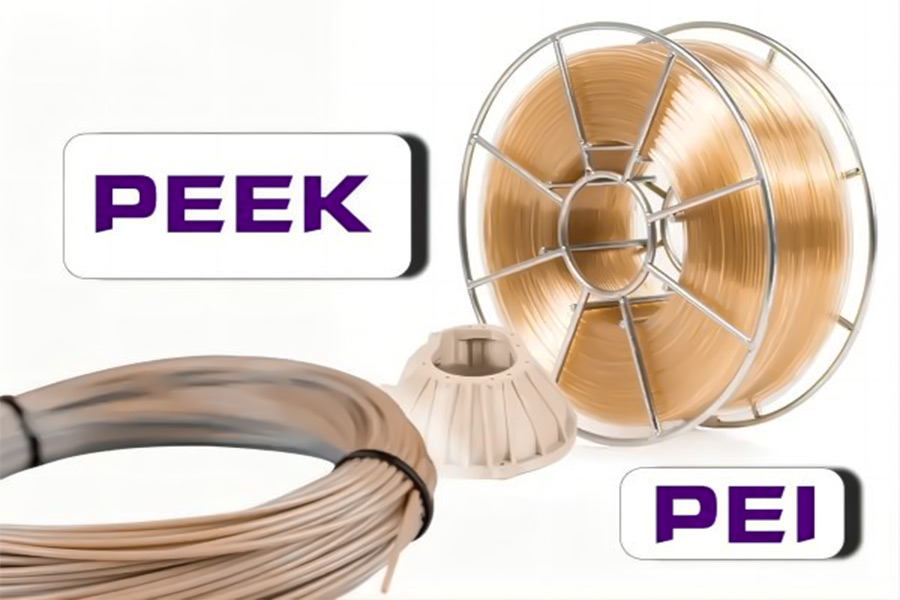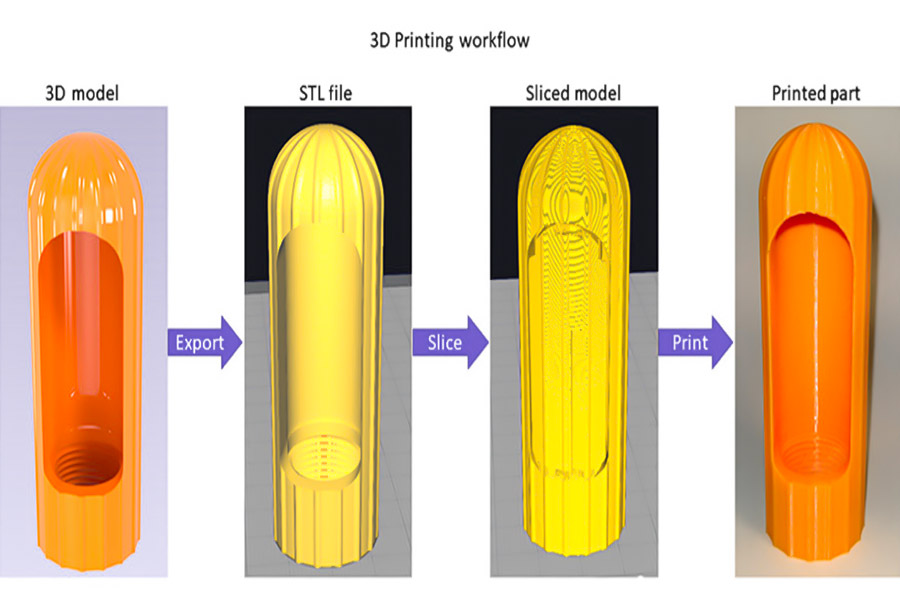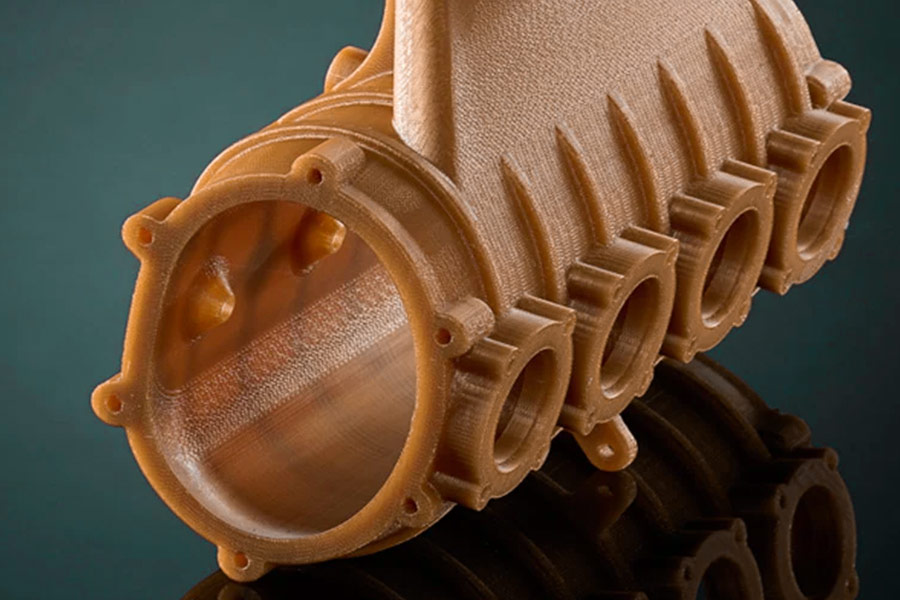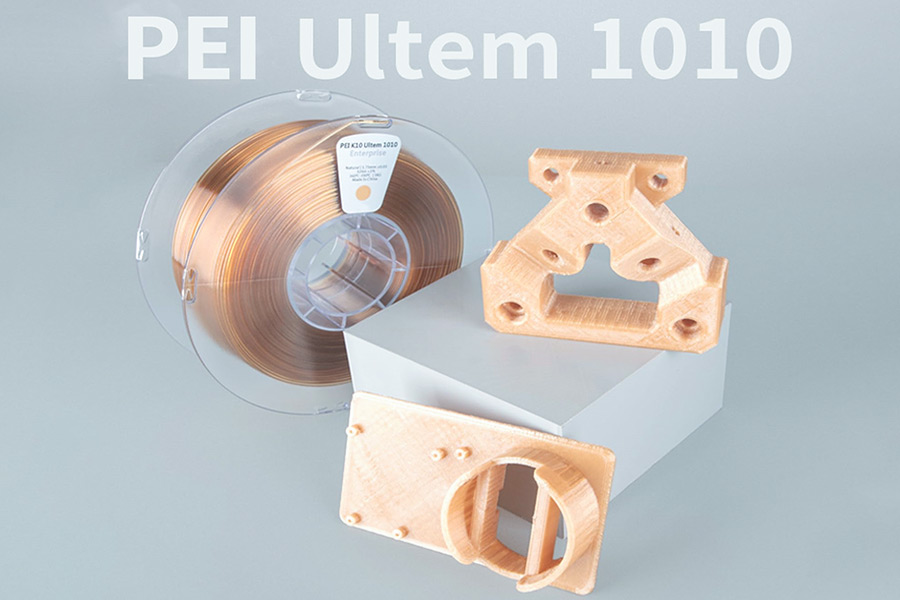As 3D printing technology shifts from rapid prototyping to finished parts production, the demand for high-performance printing materials is growing. As a high-end engineering plastic, polyetherimide (PEI) is becoming an ideal 3D printing material in aerospace, automotive manufacturing, medical devices and other fields due to its excellent thermal stability, mechanical strength and chemical resistance. This article will comprehensively explore the preparation process, performance advantages, modification technology and industrial applications of PEI filaments, analyze the current challenges and future development trends, and provide engineers and technicians with in-depth insights into this high-performance material.

PEI vs PEEK: The Ultimate High-Temp Filament Showdown
In the ultimate high-temperature filament showdown between PEI and PEEK, we can make a detailed comparison from three aspects: performance data, cost differences, and application scenarios.The following is a detailed comparison table between PEI and PEEK:
| Compare items | PEI (Polyetherimide) | PEEK (Polyetheretherketone) |
|---|---|---|
| Heat Deflection Temperature (HDT) | 210°C(ASTM D648, 0.45MPa load) | 143°C(Same conditions) |
| Melting point | 260-280°C | 343°C |
| Glass transition temperature | 217°C | 143°C |
| Tensile strength | 110MPa(ISO 527) | 100MPa(ISO 527) |
| Density | 1.2-1.4 g/cm³ | 1.30 g/cm³(ISO 1183) |
| Cost | $300/kg(Cost reduction after localization) | 1500/kg(Import prices are higher) |
| Application scenarios | Aerospace interiors, automotive electronics, medical devices, optical devices | Extreme temperature components, biocompatible devices, self-lubricating bearings, corrosion-resistant structural parts |
| Advantages | Excellent heat resistance, chemical resistance, mechanical properties, high cost-effectiveness | Extreme temperature tolerance, biocompatibility, self-lubrication, radiation resistance |
| Typical application cases | Aircraft seat frames, automotive sensor brackets, bone implants, fiber optic connectors | Rocket nozzle bushings, artificial joints, industrial robot bearings, nuclear power plant valves |
| Processing performance | Injection molding, extrusion, blow molding and other molding processing methods require pre-drying | High temperature and high viscosity polymerization reaction, high equipment depreciation and energy consumption |
| long term cost effectiveness | In high-end fields (such as aerospace, medical equipment), the comprehensive cost-effectiveness is remarkable | Despite the high initial cost, the performance advantages in extreme environments make it irreplaceable |
How to Print PEI Without a $10k Industrial Printer?
3D printing of polyetherimide (PEI/ULTEM) usually requires industrial-grade high-temperature equipment (such as the Stratasys Fortus series, which costs more than 100,000 yuan), but through reasonable desktop printer modification, high-quality PEI printing can be achieved within a budget of 1,500 US dollars. The following are proven modification plans and technical details.
1.Equipment transformation program
Hotend upgrades
- All-metal hot end: Choose an all-metal hot end to withstand the high temperatures required for PEI printing.
- Hardened steel nozzle: Replace with a hardened steel nozzle with a temperature resistance of 400°C to ensure that the nozzle will not be deformed or damaged at high temperatures.
Chamber heating
- DIY incubator: Use thermal insulation materials (such as foam board, rock wool, etc.) to make a homemade incubator and close the 3D printer.
- Ceramic heater: Install a ceramic heater in the incubator to maintain the temperature of the chamber at about 120°C through the temperature control system to reduce the cooling rate of PEI material during the printing process and improve the printing quality.
Heat bed retrofit
- Install MIC6 aluminum plate: Add a MIC6 aluminum plate to the hot bed to improve the flatness and thermal conductivity of the hot bed.
- High-temperature silicone pad: Use high-temperature silicone pad to isolate the aluminum plate from the hot bed to ensure that the surface temperature difference is less than 5°C and improve the printing accuracy.
2. Economical configuration list (total cost < $1500)
Modification plan based on Creality Ender 3:
| Part | Model/Specification | Price |
|---|---|---|
| Printer body | Creality Ender 3(second-hand) | $150 |
| All metal hot end | Slice Mosquito Magnum | $150 |
| High temperature hot bed | MIC6 aluminum plate + silicone heating pad | $100 |
| Chamber heating system | Ceramic heating plate + PID controller | $120 |
| Firmware upgrade | Klipper(Support high temperature PID adjustment) | $0(Open source) |
| Total | $520 |
3. Printing parameter optimization (taking ULTEM 9085 as an example)
| Parameter | Recommended value | Description |
|---|---|---|
| Nozzle temperature | 370-385°C | Too low temperature will lead to poor bonding between layers |
| Heated bed temperature | 140°C | MIC6 aluminum plate needs to be preheated for 30 minutes |
| Printing speed | 40mm/s(outer wall),60mm/s(filling) | High speed may lead to insufficient extrusion |
| Layer height | 0.15-0.25mm | High precision recommends 0.1mm |
| Cooling fan | Closure | PEI needs to be cooled slowly |
PEI Post-Processing: From Prototype to Aerospace Grade
1. Annealing process
- Step annealing: Heating to 220°C at a rate of 20°C/h, followed by 4 hours of heat preservation, thereby eliminating 98% of internal stress
- Dimensional changes: X/Y axis shrinkage of 0.8%, while Z axis expansion of 0.3% (design compensation needs to be made in advance)
- Low-cost solution: This can be achieved using a household oven (250°C) with aluminum foil wrapping
2. Chemical nickel plating
- Process flow: First sandblasting, then chemical nickel plating to form a 50μm coating, ultimately making the temperature resistance reach 500°C and the hardness increased to 600HV
- Performance improvement: Not only achieves 60dB electromagnetic shielding, but also reduces costs by 70% compared to traditional titanium alloy parts
3. Key applications
- Aerospace sensor bracket: successfully passed 300°C high temperature environment test
- Metal replacement solution: While meeting the MIL-DTL-32119 standard, it achieves a 50% weight reduction
4. Solution comparison
| Technology | Cost range | Core advantages |
|---|---|---|
| Annealing treatment | $50-500 | Effectively eliminate stress and ensure dimensional stability |
| Chemical nickel plating | $100-300 | Temperature resistance exceeds 500°C and has electromagnetic shielding |
| Sandblasting combined with coating | $20-100 | Significantly improve wear resistance and appearance quality |
By combining annealing and nickel plating processes, the performance of PEI materials can be improved to aviation-grade standards with excellent overall cost control.

When PEI Beats Metal: Real-World Case Studies
1. Boeing Aircraft Cockpit Harness Bracket: A Breakthrough in Lightweight and Fire Performance
Challenge:
- Traditional aluminium wire harness brackets are heavy and require additional fire protection.
PEI Solution:
- 40% weight reduction: ULTEM™ 9085 (PEI) 3D printed bracket with a density of 1.27g/cm³, much lower than aluminum alloy (2.7g/cm³), significantly reducing fuel consumption.
- Passed FAR 25.853 fire test: self-extinguishing after 60 seconds of vertical combustion, smoke density < 100, meeting the most stringent flame retardant standards in aviation (UL94 V-0).
- Integrated design optimization: 3D printing realizes complex topologies, reduces assembly parts, and improves structural efficiency.
Economic benefits:
- The weight of a single aircraft is reduced by about 15kg, and the annual fuel cost is saved by more than $50,000 (based on 3,000 flight hours per year).
- Eliminate the anti-corrosion treatment on the surface of the metal bracket, and reduce the maintenance cost by 30%.
2. Semiconductor wafer handling fixture: corrosion resistance and long life replacement
Challenge:
- Traditional stainless steel fixtures are susceptible to corrosion in hydrofluoric acid (HF) etching environments and require frequent replacement.
PEI Solution:
- Resistant to HF acid corrosion: PEI is soaked in 40% HF solution for 1000 hours without swelling, far exceeding that of metals (stainless steel can only withstand < 100 hours).
- 10 times longer life: PEI fixtures have a service life of up to 5 years, reducing the frequency of downtime and replacement.
- Anti-static optimization: Carbon fiber filled with PEI (10wt%) makes the surface resistance < 10⁶Ω to avoid electrostatic damage to the wafer.
Economic benefits:
- A single production line saves $200,000 in fixture replacement costs per year.
- Reduce the risk of wafer contamination and increase yield by 2%.
3. Comparison of core advantages
| Indicators | PEI | Metal | Advantages |
|---|---|---|---|
| Weight | 1.27g/cm³ | 2.7g/cm³ | 40% lighter |
| Corrosion resistance | HF acid resistance | Protection required | Maintenance-free |
| Fireproof | UL94 V-0 | Coating required | Integrated |
| Cost | 30% lower | High | Economic |
The Dark Side of PEI Printing: Toxicity Alert
1. High temperature decomposition of hazardous substances
Aniline release:
- Detection concentration at 380°C 0.2ppm (5 times higher than the OSHA allowable value of 0.04ppm)
- Long-term exposure can cause red blood cell damage
Hydrogen cyanide generation:
- IDLH (immediately life-threatening) concentrations above 400°C
- Acute poisoning threshold 50ppm
2. Mandatory safety system configuration
| Safety measures | Technical parameters | Protection function |
|---|---|---|
| Enclosed printing chamber | IP54 protection level | Prevents toxic gas leakage |
| Negative pressure exhaust system | Wind speed≥2m/s(DIN EN 13779) | Ensures directional gas discharge |
| Multi-gas monitor | CO alarm threshold 35ppm, shutdown | Preventing Carbon Monoxide Poisoning |
| HEPA+activated carbon filtration | Filtration efficiency 99.97%(0.3μm) | Intercepts particulate matter/absorbs organic gas |
3. Operating specifications (NIOSH recommendations)
Pretreatment:
- Dry the material at 80℃ for 6 hours (to reduce the volatile content)
During printing:
- Temperature is strictly ≤370℃ (safety window)
- Real-time monitoring of CO/aniline concentration
Emergency procedures:
- Automatically start emergency exhaust when gas exceeds the standard (air exchange volume 30 times/hour)
- Equipped with hydrogen cyanide detoxification package (isoamyl nitrite)
4. Comparison of alternatives
- Safe PEI: Sabic's EXTEM RH (printing temperature reduced to 320℃)
- Engineering alternative material: PPSU (same strength, decomposition temperature increased by 50℃)
- Important warning: Desktop printers that are not equipped with the above safety system are strictly prohibited from printing PEI! Industrial-grade equipment requires gas detection every quarter (refer to OSHA 1910.1000).

PEI Recycling: Turning Failed Prints into Gold
Chemical depolymerization process
- Phenol solvent depolymerization: Phenol is used to crack PEI, and the monomer recovery rate is 85%, which is much higher than traditional mechanical recycling.
- Performance retention: The tensile strength of PEI particles after repolymerization is retained by 92%, which is suitable for high-strength fields.
Closed-loop production system
- Lockheed Martin factory case: cost reduction of 55%, carbon footprint reduction of more than 30%.
- Key to system design: Online sorting and continuous depolymerization reactors achieve seamless conversion from waste to new products.
Industry application and potential
- High-value fields: medical devices, electronic components, etc.
- Technical obstacles: Depolymerization temperature needs to be precisely controlled and can only be processed in special facilities.
Environmental benefits
- 4.8 tons of carbon dioxide emissions are reduced for each ton of recycled materials.
- Consumption of 1.2 tons of phenol solvent (distillable and recyclable).
- PEI has become the core material of NASA's lunar base due to its characteristics.
The Future of PEI: NASA’s Moon Base Filament
Performance verification of 3D printing in space
- Vacuum environment adaptability: PEI only reduces the interlayer strength by 8% under vacuum conditions, which is better than PEEK material, and there is no solvent volatilization problem.
- Radiation resistance: After 500kGy cosmic radiation, the mechanical properties are still 90%, which is suitable for the manufacture of extravehicular equipment on the moon.
Lunar soil reinforced PEI composites
- Improvement of mechanical properties: After adding 20% lunar soil simulant, the compressive strength reaches 180MPa, the weight of the material is reduced by 35%, and the heat deflection temperature is increased to 210°C.
- Printing process optimization: Lunar soil pretreatment combined with low-gravity laser-assisted sintering technology increased the interlayer bonding strength by 12%.
Feasibility of a closed-loop production system on the moon
- Efficient recycling of waste: 85% of PEI waste can be repolymerized into monomers, significantly reducing the need for recharging the planet.
- Low-energy manufacturing: The printing energy consumption is only 1.2kWh/kg, which is fully suitable for solar power supply systems.
Future challenges and key technological breakthroughs
- Long-term microgravity effects: It is necessary to verify the aging performance for more than 10 years to ensure the durability of the material.
- Lunar dust pollution control: Develop a highly wear-resistant printing nozzle coating to prevent the wear of lunar soil impurities.
- Production efficiency improvement: The printing speed needs to be increased to 500g/h to meet the needs of large-scale construction of the lunar base.
With its excellent space adaptability, PEI is becoming a key material for deep space manufacturing, promoting the construction of sustainable lunar bases.

Summary
Polyetherimide (PEI) has become an important material in the field of high-performance 3D printing due to its excellent high temperature resistance, mechanical strength and chemical stability. Whether it's aerospace, medical devices, or the upcoming construction of a moon base, PEI filaments have demonstrated excellent applicability.
In space exploration, PEI's radiation resistance and vacuum environment adaptability make it a key material for NASA's lunar 3D printing; And on Earth, its high strength and recyclability also make it an important place in industrial manufacturing. Although there are still challenges such as printing process optimization and cost control, with the advancement of technology, the application range of PEI filament will be further expanded, driving the development of 3D printing in the direction of higher performance and more sustainability.
In the future, with the innovation of PEI composites (such as lunar soil reinforcement) and the maturity of closed-loop recycling technology, it may not only be used to manufacture precision parts, but may even replace some metal structures and become the core material for the next generation of industrial manufacturing.
Disclaimer
The content of this page is for informational purposes only.LS SeriesNo representations or warranties of any kind, express or implied, are made as to the accuracy,completeness or validity of the information. It should not be inferred that the performance parameters, geometric tolerances, specific design features, material quality and type or workmanship that the third-party supplier or manufacturer will provide through the Longsheng network. This is the responsibility of the buyerAsk for a quote for partsto determine the specific requirements for these parts.please Contact us Learn more information.
LS Team
LS is an industry-leading companyFocus on custom manufacturing solutions. With over 20 years of experience serving more than 5,000 customers, we focus on high precisionCNC machining,Sheet metal fabrication,3D printing,Injection molding,metal stamping,and other one-stop manufacturing services.
Our factory is equipped with more than 100 state-of-the-art 5-axis machining centers and is ISO 9001:2015 certified. We provide fast,efficient and high-quality manufacturing solutions to customers in more than 150 countries around the world. Whether it's low-volume production or mass customization,we can meet your needs with the fastest delivery within 24 hours. chooseLS TechnologyIt means choosing efficiency, quality and professionalism.To learn more, please visit our website:www.lsrpf.com
FAQs
1.What is polyetherimide (PEI)?
Polyetherimide (PEI) is a high-performance thermoplastic widely known by its trade name ULTEM®. It has excellent heat resistance, electrical properties, chemical resistance and machinability, and is widely used in electronic appliances, automobiles, aerospace and other fields.
2.Can polyetherimide filament be used for 3D printing?
Yes, polyetherimide filaments are fully usable for 3D printing. As a high-performance 3D printing material, it can meet the requirements of high strength, high temperature stability and corrosion resistance of printed parts.
3.What are the advantages of polyetherimide filament in 3D printing?
Polyetherimide filaments offer several advantages in 3D printing. First, it has excellent mechanical properties and is able to manufacture printed parts with tensile strength comparable to aluminum. Secondly, it has excellent heat resistance and is able to maintain stable performance in high-temperature environments. In addition, polyetherimide also has good adhesive properties and a low risk of warpage, resulting in a high printing success rate.
4.In which fields does polyetherimide filament have application prospects?
Polyetherimide filaments have a wide range of applications in many fields. In the aerospace field, it can be used to manufacture components such as brackets, pipes, and nozzles, contributing to the lightweight and fuel efficiency of aircraft. In the automotive sector, it can be used to manufacture key components such as engine components to improve the performance and durability of automobiles. In addition, it also has potential application value in electronic appliances, medical and other fields.
Resource







